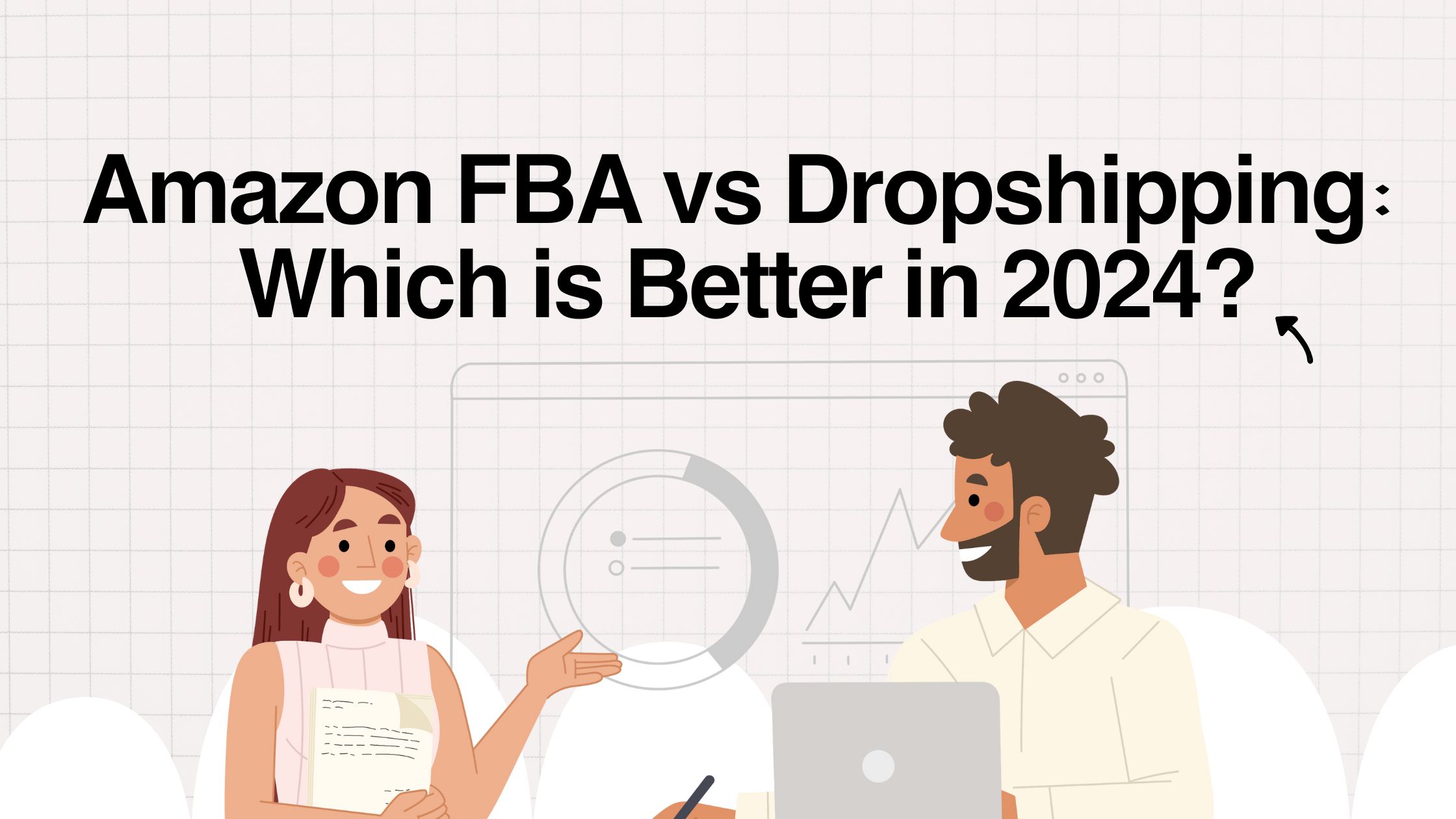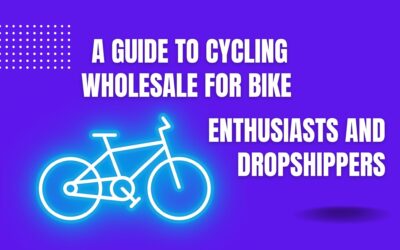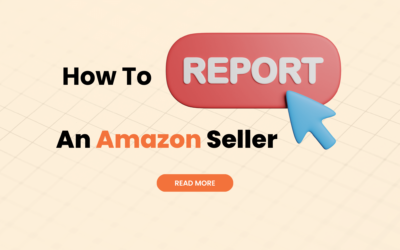Amazon FBA vs Dropshipping: Which is Better in 2024?
Amazon FBA vs Dropshipping? Choosing between Amazon FBA and dropshipping is a big decision for any e-commerce business.
Amazon FBA takes care of storage, packing, and shipping for you using Amazon’s own network. This is great because you can also tap into Amazon’s huge base of customers.
On the other hand, dropshipping lets you sell products without holding any inventory. You focus on marketing and sales, and when someone buys a product, it ships directly from the supplier to the customer.
This means you can start with less money upfront. Both options have their perks and downsides, so it really depends on what fits best with your business goals and what resources you have available.
What is Amazon FBA?
Amazon FBA, or Fulfillment by Amazon, is a service where sellers can outsource storage, order fulfillment, and customer service to Amazon.
This process involves setting up an account, listing products, and shipping inventory to Amazon’s fulfillment centers, where Amazon then manages packing shipping, and customer interactions.
How It Works
To start using Amazon FBA, you first need to set up a seller account on Amazon and adjust your FBA settings through something called Seller Central.
Next, you add your products to the Amazon catalog and mark them for FBA.
After that, you get your products ready following Amazon’s specific packing rules and send them off to Amazon’s fulfillment centers.
Once your items reach Amazon, they take care of the rest.
They store your inventory, and when someone buys your product, Amazon handles the packing and shipping straight to the customer.
Plus, they deal with customer service and returns for you.
This lets you spend more time on marketing your products and developing new ones.
Key Features
Taking a look at Amazon FBA, we see some great features like Prime eligibility, a huge logistics network, and awesome customer support.
- Prime Eligibility: Helps products get noticed and sell faster.
- Global Logistics Network: Makes sure deliveries are quick and dependable.
- 24/7 Customer Support: Builds trust and keeps customers coming back.
What is Dropshipping?
Dropshipping is a way for sellers to sell products without having to keep those products in stock. Instead of having a store full of items, sellers work with suppliers who ship products directly to customers when they buy something.
When an order is placed, the seller forwards the order details to a supplier, who then ships the product directly to the customer.
This model is known for its low startup costs, minimal inventory management, and operational flexibility.
Here’s a quick breakdown comparing dropshipping to traditional retail:
|
Aspect |
Traditional Retail |
|
Inventory Management |
Sellers keep products in stock |
|
Upfront Investment |
Usually high |
|
Logistics |
Seller manages shipping |
|
Scalability |
Depends on how much stock you have |
How It Works
Dropshipping is pretty straightforward.
First, sellers pick out products from suppliers and list them on their online store. They add all the important details like descriptions, prices, and photos.
When a customer buys something, the seller sends the order details to the supplier. This can be done automatically or manually by email.
Then, the supplier takes over. They package and ship the product directly to the customer.
Meanwhile, the seller keeps in touch with both the customer and the supplier to make sure everything goes smoothly.
This way, the seller doesn’t have to deal with stocking products, which cuts down on costs.
Key Features
Dropshipping is a top pick for e-commerce entrepreneurs mainly because it’s easy on the wallet. You don’t need a lot of money to start, as you won’t have to buy a bunch of products in advance.
- Low Risk: You don’t have to buy products before you sell them, so there’s less risk of losing money.
- Easy to Manage: No piles of products to keep track of, so you can focus more on marketing and customer service.
- Work From Anywhere: You can manage your business from anywhere in the world, which is perfect if you love flexibility and freedom.
Key Differences Between Amazon FBA and Dropshipping
To comprehensively understand the distinctions between Amazon FBA and dropshipping, one must consider key aspects such as inventory ownership, logistics and fulfillment, customer service, and market access.
Here’s a quick key differences overview:
|
Feature |
Amazon FBA (Fulfillment by Amazon) |
Dropshipping |
|
Inventory Management |
Amazon stores and manages your inventory in their warehouses |
No inventory held by the seller; products are shipped directly from supplier |
|
Upfront Investment |
Requires significant upfront investment to purchase inventory |
Low upfront investment; you only pay for products sold |
|
Fulfillment |
Amazon handles packing, shipping, and customer service |
Supplier handles packing and shipping, but the seller manages customer service |
|
Shipping Speed |
Typically fast shipping due to Amazon’s extensive logistics network |
Dependent on the supplier’s location and shipping methods |
|
Control Over Branding |
Limited control over branding and packaging |
Greater control over branding and packaging if supplier allows |
|
Fees |
Charges for storage, fulfillment, and other services |
Typically lower fees, but margins can vary widely |
|
Platform Dependency |
Highly dependent on Amazon’s platform and policies |
Can use multiple platforms or an independent online store |
|
Customer Trust |
High trust due to Amazon’s brand and customer service |
Trust must be built through the seller’s own efforts |
|
Return Handling |
Amazon handles returns and customer service |
Seller is responsible for managing returns and customer service |
|
Profit Margins |
Potentially lower margins due to various Amazon fees |
Can have higher margins but depends on supplier prices and competition |
|
Scalability |
Easily scalable with Amazon’s logistics support |
Scalability depends on supplier reliability and product demand |
|
Product Selection |
Limited to what you can purchase and send to Amazon |
Vast selection of products available from various suppliers |
Inventory Ownership
Amazon FBA means you have to buy and keep track of your inventory, which is then stored at Amazon’s warehouses.
On the flip side, dropshipping lets you sell products without actually having to stock any items yourself. This key difference really changes how each of these business models works.
With Amazon FBA, you need to shell out some cash upfront for your products, pay storage fees, and make sure you don’t have too much or too little inventory.
Dropshipping skips the whole buying inventory part since products go straight from the supplier to your customer when ordered.
|
Feature |
Amazon FBA |
Dropshipping |
|
Inventory Ownership |
Yes |
No |
|
Upfront Investment |
Required |
Not Required |
|
Stock Management |
Necessary |
Not Necessary |
Getting the hang of these differences is really important if you’re thinking about getting into the e-commerce game.
Logistics and Fulfillment
When you look at how Amazon FBA and dropshipping handle shipping and handling, there are some pretty big differences.
With Amazon FBA, Amazon takes care of everything from storing products to sending them out to customers. Sellers just send their stuff to Amazon’s warehouses, and Amazon does the rest. They make sure things get where they need to go fast, which is really handy if you’re a Prime member.
On the flip side, dropshipping puts the suppliers in charge of shipping. If someone orders something, the supplier sends it right to the customer.
This way, the sellers don’t have to keep products with them, but they also don’t get to control how fast customers receive their orders. This could make some customers unhappy if things take longer to arrive.
Customer Service
Customer service really sets Amazon FBA apart from dropshipping. When you use Amazon FBA, Amazon takes care of all the customer service stuff. They talk to customers for you, handle refunds, and take care of returns, which means you don’t have to worry about it.
On the other hand, if you’re into dropshipping, you’ve got to handle all the customer service on your own. This includes dealing with complaints, processing returns, and staying in touch with your suppliers to sort out any issues.
Here’s a quick breakdown of how it works:
|
Aspect |
Amazon FBA |
Dropshipping |
|
Customer Support |
Amazon takes care of it |
You need to manage it |
|
Returns Handling |
Amazon deals with returns |
You need to take care of it |
|
Availability |
Amazon helps customers 24/7 |
Depends on how much you can handle |
|
Complexity |
Easier for you |
Needs more effort and time |
Market Access
Amazon FBA taps into a huge network, reaching customers all over the globe.
This means you can sell your products in many countries easily and quickly because Amazon’s shipping is top-notch.
On the other hand, dropshipping can get a bit tricky.
It all depends on where your supplier is located.
Sometimes, products might take longer to arrive, which can be a bummer for your customers.
Also, if your supplier isn’t reliable, it might be tough to keep your customers happy.
In short, Amazon FBA usually offers a smoother and more dependable way to reach more customers compared to dropshipping, which can be hit or miss based on your supplier’s location and reliability.
Pros and Cons of Dropshipping and Amazon FBA
Amazon FBA
Amazon FBA offers numerous advantages, including access to Amazon’s extensive customer base, fast shipping through Prime eligibility, and the convenience of outsourced logistics and customer service.
However, it also presents challenges such as higher upfront costs, ongoing fees, and the necessity of managing inventory.
Pros
Here are four pros of Amazon FBA:
1. Trusted platform and brand association
When sellers use Amazon FBA, they get to tap into Amazon’s well-known name and solid setup.
This gives them a quick boost in trust from customers. Because customers already trust Amazon, they’re more likely to buy from sellers on the platform.
This leads to more sales and customers who come back again.
Also, since Amazon is so trusted, sellers don’t have to work as hard on marketing.
This lets them put more energy into growing their business.
2. Access to Amazon’s customer base
Using Amazon FBA is like hitting the fast-forward button for sellers who want to reach more customers.
It hooks you up with Amazon’s huge number of shoppers who come back all the time.
This means your products get seen by lots of eyes every day, which can really help you grow your sales and get your brand out there.
Plus, being part of Amazon means you’re playing on a big field, trusted by people all over the world.
3. Prime eligibility and fast shipping
When sellers use FBA (Fulfillment by Amazon), they tap into a huge group of customers.
Their products can get the Prime badge, which means fast, free shipping for lots of Prime members.
This quick shipping makes customers happy and they might buy more in the future.
Products with Prime are more visible and tend to attract more buyers, which can increase sales.
4. Hands-off logistics and customer service
Amazon FBA is a cool way to let Amazon handle the tough stuff like shipping and customer service.
This means sellers can focus more on growing their business.
Amazon uses its big network to make sure things get delivered on time and deals with returns smoothly.
This helps improve customers’ shopping experience while making life easier for sellers by cutting down on their workload.
Cons
Here are three cons of Amazon FBA:
1. Higher upfront costs and ongoing fees
Using Amazon FBA can be a bit pricey at first.
It comes with costs like storing your goods and getting them fulfilled.
You’ll need to pay up front for the inventory and the shipping to Amazon’s warehouses, plus there are monthly fees for keeping your stuff there.
If your items don’t sell fast, you might end up paying even more.
This can make it tough to manage your money and affect how much profit you can make.
2. Limited branding opportunities
When you sell products on Amazon FBA, there’s a bit of a downside when it comes to getting your brand out there.
Since everything is kind of wrapped up under the Amazon name, customers might not really recognize that it’s the company they’re buying from. They just see Amazon.
This makes it tough to make your brand stand out and build a loyal customer base.
Without strong brand identity, it’s harder to keep customers coming back to you, specifically in a market full of competitors.
3. Inventory management requirements
Handling inventory is quite the task for those selling on Amazon FBA. It’s all about planning and keeping things organized to make sure your products are always ready to go at Amazon’s fulfillment centers. You need to keep a close eye on your inventory to prevent running out of stock or having too much of it.
- Stock Management: Keep checking your stock regularly.
- Fulfillment Center Fees: Plan smartly to keep costs down.
- Demand Forecasting: Try to guess how much you’ll sell pretty accurately.
Keeping these points in check helps in managing things smoothly and avoids any major hiccups with your inventory.
Dropshipping
Dropshipping offers several advantages, including low startup costs and minimal risk, making it an attractive option for new entrepreneurs.
However, it also comes with challenges such as less control over product quality and shipping times, which can impact customer satisfaction.
Pros
Here are four pros of dropshipping:
1. Low startup costs
Starting a dropshipping business is pretty affordable.
You don’t need to spend a lot on buying inventory in advance. Instead, you can just list products and take orders, which doesn’t require a lot of money.
This makes it a good option if you don’t have a big budget.
Compared to traditional retail, it’s way easier to get into because of these lower costs.
2. Minimal risk and investment
Dropshipping’s low startup costs make it a great choice for new entrepreneurs.
You don’t have to buy inventory ahead of time, which means you don’t spend much money at the start.
This setup lets you try selling different products and exploring new markets without a big financial risk.
It’s a smart way to run a business because you can adjust quickly and easily without losing a lot of money.
3. Flexibility and ease of entry
Dropshipping is super flexible and easy to start.
It lets you kick off your business without a huge investment or dealing with a lot of complicated steps.
With this model, you don’t have to worry about keeping products in stock or shipping them out.
This means you can really focus on marketing and getting customers.
Plus, you can run your business from anywhere as long as you have internet access.
That’s why dropshipping is a great choice for many people starting out.
4. Ability to offer a wide range of products
Dropshipping is super cool because it lets you offer lots of different products without having to spend a ton of money upfront or worry about where to store them all.
This means you can easily switch things up based on what customers are into at the moment, giving you a leg up on the competition.
|
Product Variety |
Inventory Management |
Upfront Costs |
|
Lots |
You don’t handle it |
Very low |
|
Wide selection |
Handled by the supplier |
Low |
|
Follows trends |
No storage needed |
Flexible |
|
Seasonal items |
Easy to adjust |
Safe to try out |
Cons
Here are three cons of dropshipping:
1. Less control over product quality and shipping times
When you’re selling stuff through dropshipping, keeping an eye on product quality and shipping times can be a bit tricky. This can make shopping with you a hit-or-miss experience for customers, which isn’t great.
Since you depend on suppliers and they can be a mixed bag, deliveries might not always arrive on time, and the quality of products can be all over the place.
- Product Quality: Sometimes, the stuff you send out might not meet the high standards your customers expect, leading them to feel let down.
- Shipping Times: Delivery can be a guessing game. If packages show up late, it can frustrate your customers and they might leave bad reviews.
- Supplier Reliability: Not all suppliers are reliable. If they drop the ball, it can cause delays with your orders.
Handling these challenges well can make a big difference in keeping your customers happy and coming back for more.
2. High competition and lower profit margins
Dropshipping sure has its ups and downs.
One big challenge is the fierce competition. Since it’s pretty easy to get started, lots of people jump in.
This means there are tons of sellers out there, which can push prices down.
Because of this, the profit margins in dropshipping are usually pretty slim.
To make a good profit, you need to sell a lot of products, which isn’t always easy.
3. Responsibility for customer service and returns
One big problem with dropshipping is that the seller has to take care of customer service and returns.
This is different from using a service like Amazon FBA, where Amazon handles these issues.
When you’re dropshipping, you need to deal with customer questions, complaints, and returns all by yourself.
This can be a lot of work, especially if you’re working with several suppliers.
It might make customers unhappy and increase the amount of work you have to do.
Suitability for Different Business Types
When considering Amazon FBA versus dropshipping, assessing which model aligns best with your business type is crucial.
Amazon FBA is well-suited for businesses with substantial capital aiming for rapid scalability and leveraging Amazon’s robust infrastructure.
On the other hand, dropshipping is ideal for new entrepreneurs, those with limited budgets, and businesses looking to test products without significant upfront investment.
Amazon FBA
Amazon FBA is a great choice if you’ve got a good amount of money to start with and want to grow your business fast. With Amazon handling the heavy lifting of storage and shipping, you can get your products to customers faster and even make them Prime-eligible, which customers love.
This setup is perfect for businesses that are ready to step up their game and reach more people without the hassle of managing all the details themselves.
|
Feature |
Amazon FBA |
|
Capital Requirement |
High |
|
Growth Potential |
Very good |
|
Inventory Management |
Amazon takes care of it |
|
Customer Service |
Amazon handles it |
Using Amazon FBA means you can focus more on growing your business while Amazon takes care of the rest. It’s a solid option if you’re looking to expand quickly and use Amazon’s big network to your advantage.
Dropshipping
If you’re just starting out or on a tight budget, dropshipping is a smart way to kick off your business with little money down.
It’s pretty straightforward: you set up an online store, list products without buying them first, and only pay your suppliers when someone buys from you.
This way, you can try out new products without spending a lot of cash.
Plus, you can run your business from anywhere as long as you have internet access.
Keep in mind, though, that you won’t have much control over how fast products ship or their quality, which can sometimes upset customers and affect your business’s reputation.
Case Studies and Examples
To illustrate the practical applications of Amazon FBA and dropshipping, we will examine successful examples from each model.
Plugable Technologies leveraged Amazon FBA to expand its market reach globally, significantly boosting sales.
On the other hand, Mooshe exemplifies a flourishing dropshipping business, selling innovative vegan fabric socks with minimal upfront investment.
Amazon FBA
Plugable Technologies, a company known for its USB and Bluetooth gadgets, has really tapped into the power of Amazon FBA to grow its business.
Plugable managed to deliver products super fast and keep customers happy, which is super important when you’re dealing with tech stuff. This smart move helped them sell more and even start selling in places like Europe.
Here’s a quick look at how things changed for them:
|
Metric |
Before FBA |
After FBA |
|
Sales Growth |
Moderate |
Big jump |
|
Market Reach |
Limited |
Worldwide |
|
Okay |
Great |
This story is a great example of how using Amazon FBA can really change the game for businesses looking to grow.
Dropshipping
Let’s talk about a cool dropshipping store called Mooshe, which is all about socks made from vegan fabric.
The folks behind Mooshe really care about the environment and saw that more people were getting into sustainable fashion. They teamed up with some dependable suppliers to offer unique, high-quality socks without having to deal with a bunch of inventory themselves.
Mooshe really took off by using social media and working with influencers to spread the word.
This approach helped them build a big group of customers quickly. The success of Mooshe shows just how well dropshipping can work.
It’s a way to start a business without a lot of money upfront and keep running costs low, all while meeting the needs of specific groups of shoppers.
Mooshe is a great example of how flexible and scalable dropshipping can be.
Wrapping Up
When you’re looking at Amazon FBA and dropshipping, each has its own perks and challenges based on what you need for your business.
With Amazon FBA, you get everything taken care of – from storing your products to shipping them out. It’s great if you don’t want to deal with the logistics and have some money to invest. Plus, your products can be eligible for Amazon Prime, which is a big plus for customers.
On the other hand, dropshipping lets you start a business without needing a lot of money upfront or a place to store your products. It’s super flexible and perfect if you’re just starting out or want to keep costs low. However, you have less control over shipping and the quality of products since you’re not handling them directly.
Choosing between the two really depends on what’s more important for your business – whether that’s saving money and being flexible with dropshipping, or having a more hands-off approach and possibly reaching more customers with Amazon FBA.
Unlocking the Benefits of Bicycle Wholesalers: A Guide to Cycling Wholesale for Bike Enthusiasts and Dropshippers
Bicycle Wholesalers A Guide to Cycling Wholesale for Bike Enthusiasts and Dropshippers Hop on your...
Unpacking Zara’s E-Commerce Site Success: Strategies and Insights
Unpacking Zara's E-Commerce Site Success: Strategies and Insights So, you find yourself captivated...
Seeing Red Flags? Here’s How to Report an Amazon Seller
Seeing Red Flags? Here's How to Report an Amazon Seller Ever found yourself surfing the vast ocean...





